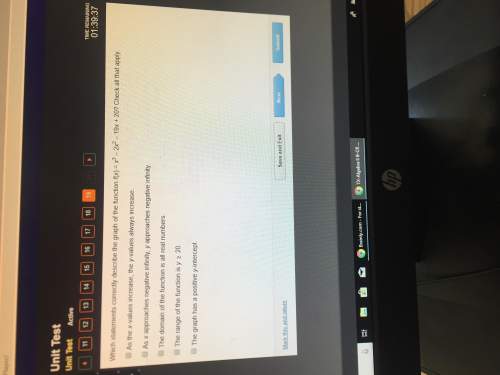
Mathematics, 07.07.2019 04:00 cork6
Suppose s and t are mutually exclusive events, p(s)=22% and p(t)=47%. find p(s or t).

Answers: 1


Another question on Mathematics

Mathematics, 21.06.2019 15:10
Polygons efgh and e′f′g′h′ are shown on the coordinate grid: what set of transformations is performed on efgh to form e′f′g′h′? a. a translation 1 unit to the left followed by a 90-degree counterclockwise rotation about the origin b. a translation 1 unit to the right followed by a 90-degree counterclockwise rotation about the origin c. a 90-degree clockwise rotation about the origin followed by a translation 2 units to the right d. a 90-degree clockwise rotation about the origin followed by a translation 2 units to the left
Answers: 1

Mathematics, 22.06.2019 00:00
Abook store is having a 30 perscent off sale. diary of the wimpy kid books are now 6.30 dollars each what was the original price of the books
Answers: 1

Mathematics, 22.06.2019 00:00
Cole says the distance between points (-5,0) and (0,-5)is 5 units. is he correct? explain why or why not.
Answers: 1

Mathematics, 22.06.2019 00:50
Assume that adults have iq scores that are normally distributed with a mean of mu equals 100 and a standard deviation sigma equals 20. find the probability that a randomly selected adult has an iq between 80 and 120.assume that adults have iq scores that are normally distributed with a mean of mu equals 100 and a standard deviation sigma equals 20. find the probability that a randomly selected adult has an iq between 80 and 120.
Answers: 3
You know the right answer?
Suppose s and t are mutually exclusive events, p(s)=22% and p(t)=47%. find p(s or t)....
Questions

Social Studies, 28.06.2020 02:01





Mathematics, 28.06.2020 02:01





Computers and Technology, 28.06.2020 02:01




Mathematics, 28.06.2020 02:01

Geography, 28.06.2020 02:01




Mathematics, 28.06.2020 02:01




